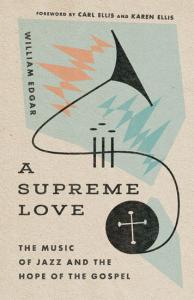I’ll be the first to admit that I don’t know much about Jazz. I know a bit about Country and less about Rock and Roll, but Jazz hasn’t really been on my radar–I’ve not even seen the Ken Burns documentary about it. Which means I’m very grateful for William Edgar’s introduction to the genre A Supreme Love: The Music of Jazz and the Hope of the Gospel.
This little book is excellent, and covers well the history and nature of Jazz. A Supreme Love puts an especially sharp focus on the relationship between Jazz and its Christian roots. (At least, I assume it covers all of this stuff well–again, I don’t know much about Jazz and maybe A Supreme Love gets every note wrong; it’s not like I would know either way.) If you’re looking for a good intro to the genre, this is a great place to go, and includes some useful suggestions for places to start listening to the music if, like me, you’re a newbie.
Yet, I’m not sure I agree with the undernote at work in the book. Don’t get me wrong, my mild disagreement here doesn’t negate Edgar’s book, I just think this is something that affects the tenor of how we read the book and listen to the music. Specifically, Edgar joins Seerveld in rejecting Plato’s categories of beauty. Specifically he argues that many of us carelessly
“associate beauty with a kind of Platonic sense of harmony, balance, and congruence. In this view, something beautiful here below is mimetic (an imitation) of a higher design.” (11)
This is not only the standard Platonic view, but it’s also the standard Christian one and endorsed by everyone from Augustine to Jonathan Edwards. Edgar highlights two problems with this view:
“One is that it imposes a category that might be foreign to the object in question. Is the image on an old Persian manuscript well understood if it qualifies as beautiful? The other problem is that some art is purposefully violent or ugly.” (11)
And here’s where I think Edgar (or, again, Seerveld, on whom he is drawing) haven’t really refuted Plato. A piece of art might in fact be genuinely ugly, but I’m not convinced that means we need to redefine beauty. In fact we don’t really have the means to declare something “ugly” if we don’t have a good working category for “beauty” in the first place. And it would seem that proportion, symmetry, balance, etc are all reasonable components of beauty. It may be that those categories are foreign to an object under consideration, but that might just mean that either the object under consideration is ugly (or neutral, if that’s a category), or that our sense of proportion, symmetry, et al is itself out of balance and we’re not properly able to interpret the object.
I suspect that has been my experience with Jazz. It’s not that there’s a problem with Jazz when my untrained ear listens to it and fails to hear the transcendent beauty others encounter. It’s that my sense of beauty in this area isn’t very well attuned to the proportion and balance at work in the music.
Again, this is a minor point relative to the work of A Supreme Love and shouldn’t take away from your appreciation either of the book or of the music. As I noted above, this is a solid little text and well worth having on your shelf.
Dr. Coyle Neal is co-host of the City of Man Podcast an Amazon Associate (which is linked in this blog), and an Associate Professor of Political Science at Southwest Baptist University in Bolivar, MO













